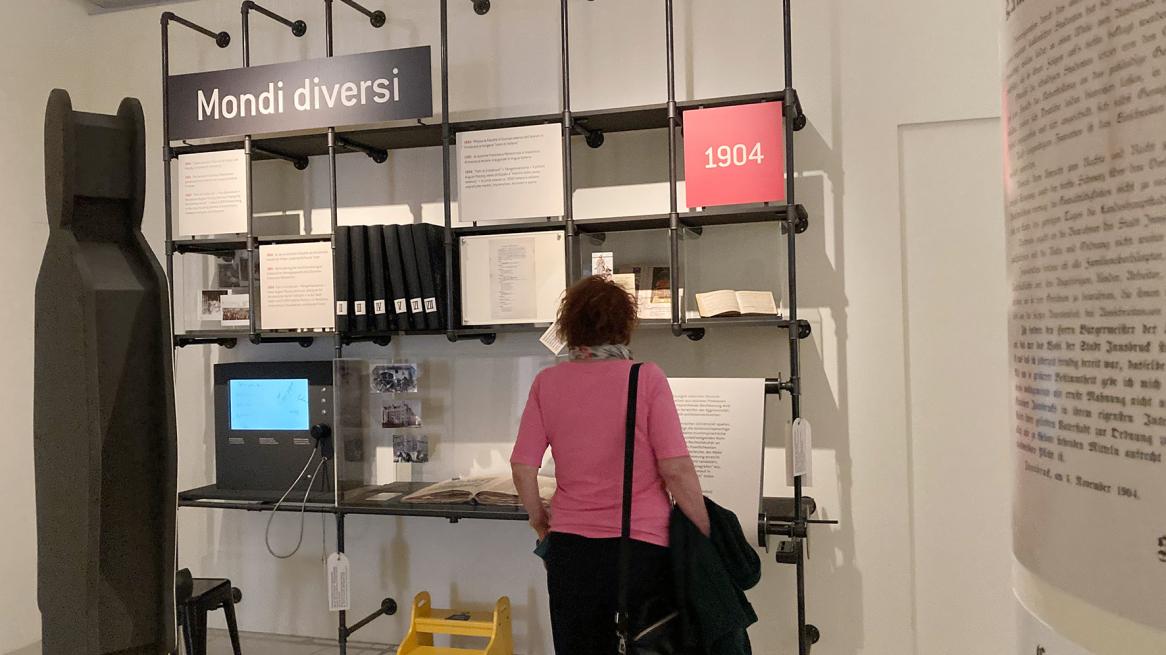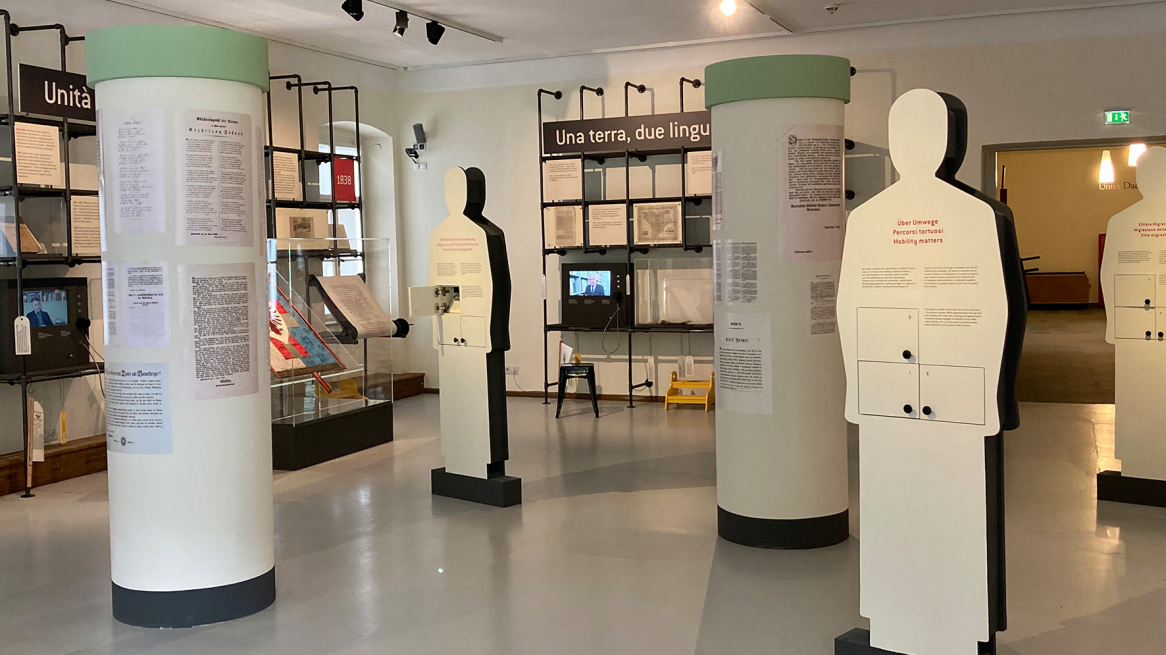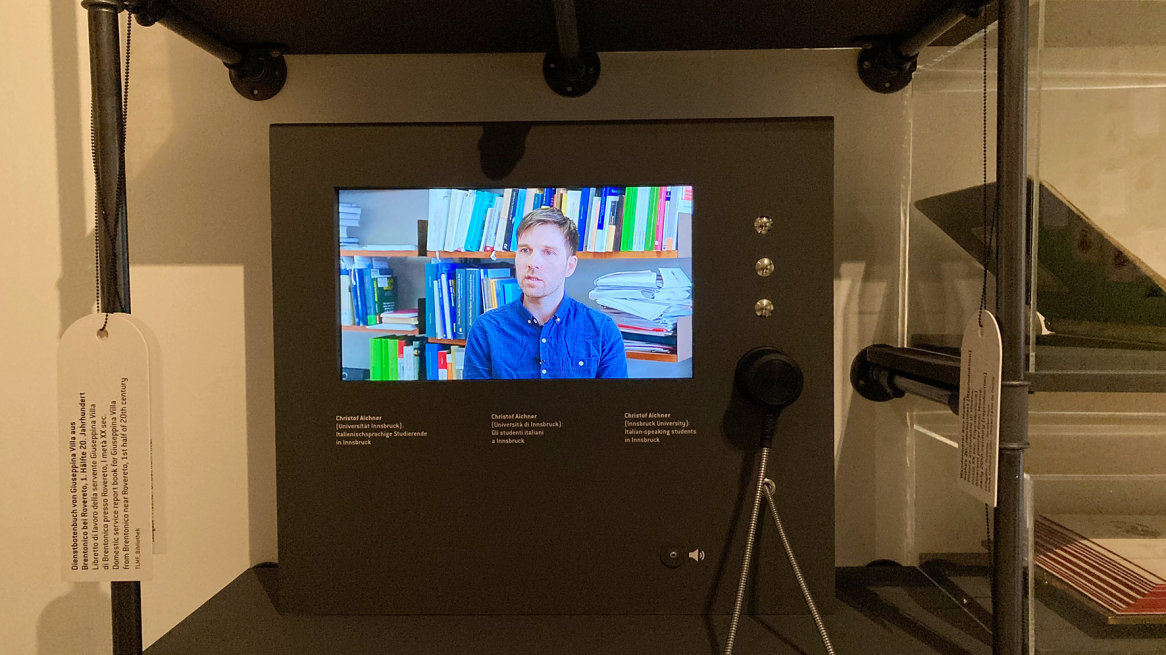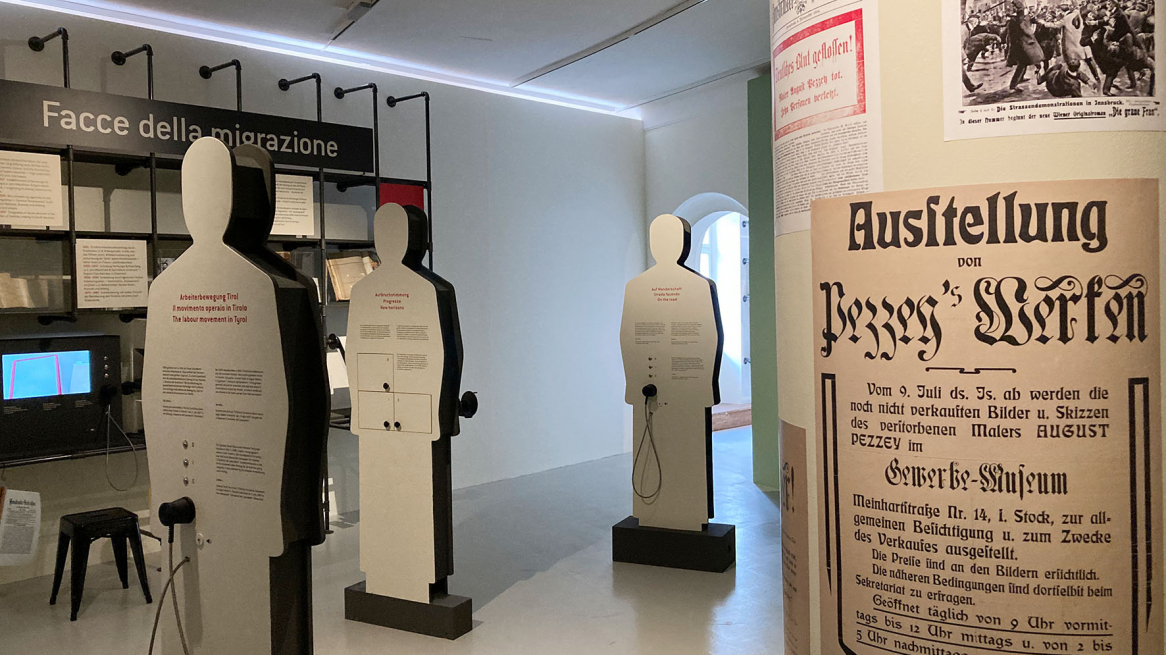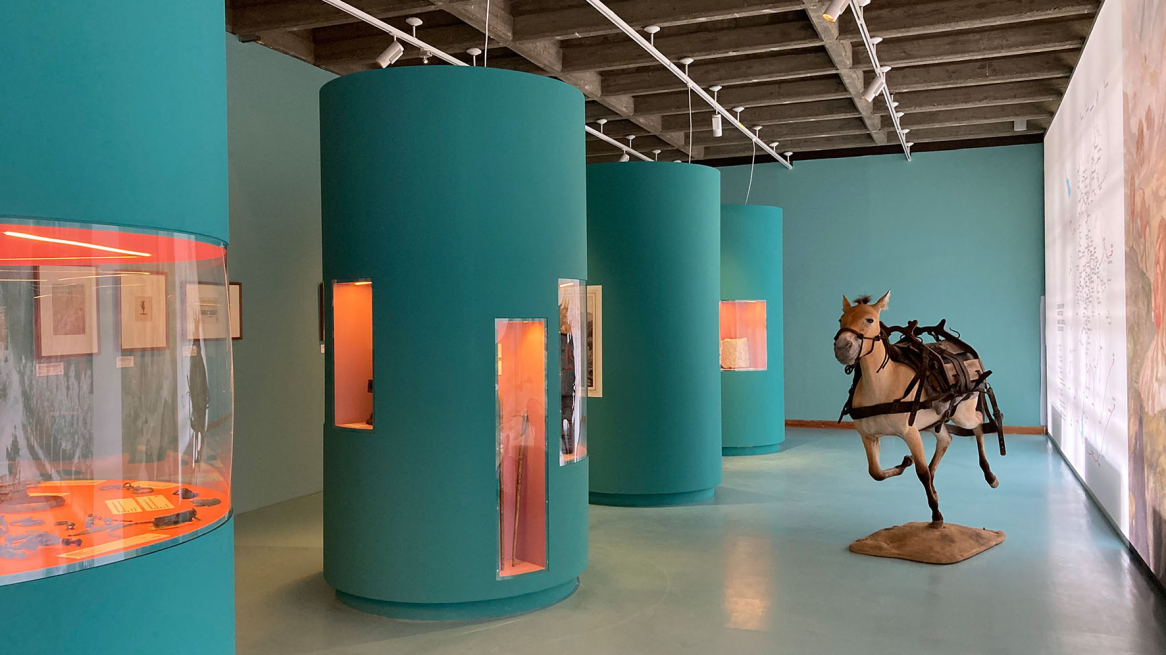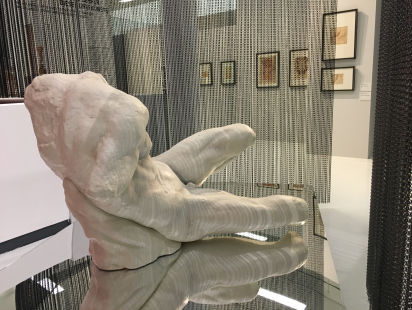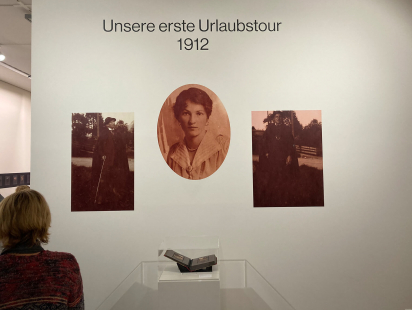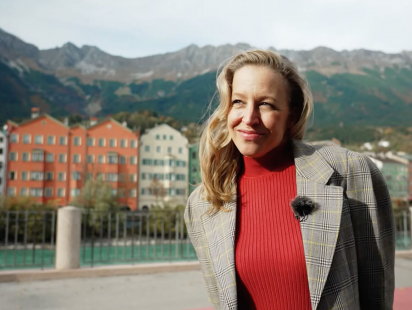Migration is an extremely exciting and very virulent topic. I still vividly remember the exhibition "Alles fremd - alles Tirol" (Everything foreign - everything Tyrol), which took place here at the Volkskunstmuseum in 2016. To read my blog post at the time, go here. And I remember the Forum Migration, carried out by the Tiroler Landesmuseum in 2018, which I was also very excited about. So many approaches, so many impressions and suggestions. "Al lavoro! On immigration from Trentino in the 19th century" thus almost follows on from a tradition, especially as the Folk Art Museum cooperated with the Centre for Migration in Tyrol (ZeMiT) this time too.
EUREGIO MUSEUM YEAR 2021
Together with the exhibition "Gehen - Fahren - Reisen. Mobility in Tyrol", which is currently taking place in the Zeughaus, the special exhibition in the Folk Art Museum is integrated into the Euregio Museum Year 2021. It focuses on the connections, the common ground of the historically closely linked regions of Tyrol, South Tyrol and Trentino.
Since the late Middle Ages, the county of Tyrol was a multilingual country. German, Ladin and Italian speakers lived side by side and with each other. The region south of the Brenner was generally referred to as "Welschtirol". At first, a distinction was made between Welschtirol (for Trentino) and Südtirol.
Until the end of the First World War, Tyrol, Südtirol and Trentino belonged together. It was not until the peace treaty of Saint Germain in 1919 that the southern part of the country fell to Italy and the Brenner Pass became the state border.
MULTILINGUAL ON THE ROAD
The exhibition picks up from the still common time, focusing on the developments in the 19th century that led to increased labour migration from Trentino.
Migrant traders and workers have always circulated. Until then, however, it was mainly the elites who moved between Trento, Bolzano and Innsbruck: Civil servants, for example, who were transferred, students who enrolled in Innsbruck, but also pupils who pursued an education at the Gewerbeschule, for example.
The historical Tyrol corresponded to its multilingualism and had a bilingual administration. From 1814 onwards, all provincial laws and ordinances were published in German and Italian.
From the middle of the 19th century, nationalism increased and with it the tensions between the language groups in Tyrol.
AL LAVORO! - OFF TO THE NORTH
In the 19th century, industrialisation and the development of railway connections between north and south, east and west promoted labour migration. Job-seekers from the Trentino region and northern Italy (especially Friuli and Veneto) came to the Wipptal, the Pustertal and the Inntal, found employment in railway and tunnel construction or hired themselves out in the new factories. In Innsbruck, for example, the textile factory Herrburger und Rhomberg, which opened in 1839, offered employment especially to women and young girls.
NETWORKED BIOGRAPHIES
How closely family stories and family trees are interwoven with the historical Tyrol is impressively demonstrated again and again in the exhibition "Al lavoro! Particularly eye-catching here is an installation that relates historical portraits and biographies.
Biographies bear witness to how closely the parts of the country were once interwoven and how they are still linked by family ties today.
There you can read about Annunziata Cortelletti, who was born in Villazzano (Trento) in 1866 and married Andreas Philadelphy in 1889. The latter originally came from what is now Slovakia. The family lived first in Trento, then in Bolzano and finally in Innsbruck.
Or by Antonio Spagnolli from Reviano d'Isera, who studied in Venice and Rome. In 1882 the sculptor moved to Innsbruck, where he created the marble portrait heads on the façade of the Tyrolean Landesmuseum Ferdinandeum.
INTERVIEWS OPEN UP WORLDS
The interviews with scholars who provide insights into specific topics are also exciting. For example, the ethnologist Anita Konrad explains what such a publication reveals about the relations between the language groups on the basis of "Vollständiges Tiroler Kochbuch für deutsche und wälsche Küche" from 1855.
The historian Gunda Barth-Scalmani, in turn, vividly conveys how the "Fatti d' Innsbruck" took place in 1904. In the course of the opening of the Italian law faculty in Liebeneggstraße, violent clashes broke out between German nationalist and Italian students. The clashes resulted in one death and several injuries. Nationalism had long since taken root.
Migration has many faces - the exhibition "Al lavoro!" at the Volkskunstmuseum sets out to find them.
END IN NATIONALISM
This had increased from the middle of the 19th century and visibly poisoned the coexistence of the language groups in Tyrol. The Fatti d' Innsbruck were one of the bloody highlights. The First World War was to increase these tensions once again. It ended with the division of Tyrol: South Tyrol and Trentino fell to Italy.
However, the connections between the region north and south of the Brenner Pass, which have grown over the centuries, are still alive today. "Al lavoro! About Immigration from Trentino in the 19th Century" makes you want to go in search of traces.
CONNECTIONS UNTIL TODAY
References to the common history can be found not only in Innsbruck family names such as Tomaselli, Boschi, Ischia, Trentini or Moschen, but also in street names such as Alois Negrelli or Artur Nikodem.
Tip: On the way to the exhibition "Gehen - Fahren - Reisen. Mobility in Tyrol" in the Zeughaus you can walk past the Ferdinandeum and look at the marble figures by Spagnolli. And if you take a detour to the Sillpark, you will find yourself on the former site of the Herrburger and Rhomberg textile factory.
Tyrolean Folk Art Museum
"Al lavoro! Get to work! On Immigration from Trentino in the 19th Century."
until 26 October 2021
Universitätsstraße 2
6020 Innsbruck
Tel. +43 512 59489 510
Opening hours: daily 9 a.m. - 5 p.m
Zeughaus
"Walking - Driving - Travelling. Mobility in Tyrol"
until 3 October 2021
Zeughausgasse 1
6020 Innsbruck
Opening hours: Tue-Sun 9.00-17.00 hrs
On the website of the Tyrolean Provincial Museums you will find the current Covid 19 protection measures.
Photos, unless otherwise stated: Susanne Gurschler
An overview of the exhibition programme in the museums in Innsbruck and the surrounding area can be found at innsbruck.info
Rate this article
Show me the location on the map
Innsbruck has captured her heart, and the view of the Nordkette mountains soothes her soul. A journalist, non-fiction author, bookworm, amateur photographer, dog owner and mountain walker #ghostsofinnsbruck
Similar articles
It is open until April 18, 2022 at the regional museum Ferdinandeum in Innsbruck…
It was some years ago that Roland Sila, head of the Ferdinandeum library, discovered…
On December 7, a new comedy series starring Nina Proll will start on ServusTV. "Aus die Maus"…
Innsbruck couldn't have dressed up better this October. The air is bone-chillingly cold, the view of the…

